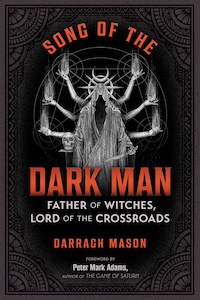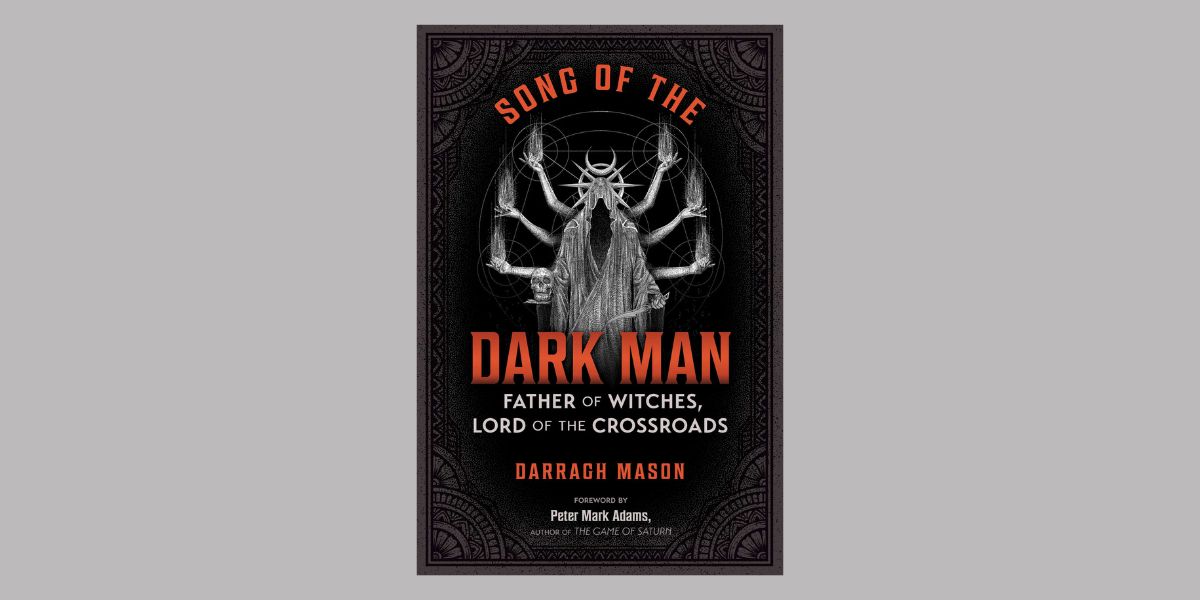
Song of the Dark Man: Father of Witches, Lord of the Crossroads, by Darragh Mason
Destiny Books, 1644119099, 208 pages, August 2024
Darragh Mason’s Song of the Dark Man beckons readers down a crooked, thorn-riddled forest path to meet the Devil at the crossroads. Following the haunting melody of his Pan pipes through a captivating blend of folktales, historical records, and contemporary testimonies, Mason seeks the elusive figure of the Dark Man of the Witches’ Sabbath, whose children are “the witches and storytellers.”1
Divided into two parts, this book delves into the historical context of the Dark Man, including the chilling accounts of the Scottish witch trials, and then explores the lived experiences of present-day witches who have encountered the Dark Man. Mason invites readers to sit beside an ancestral campfire, for “this is a work created in the spirit of the sagas and poems sung by our forebears.”2
Darragh Mason is an award-winning photographer, researcher, and author, best known for his work on the Djinn and the Aghori Hindu sect. He also hosts the award-nominated paranormal podcast Spirit Box. Mason doesn’t claim to be a scholar or an authority on witchcraft. “This book is for the curious and the haunted,”3 he says.
Mason asserts that the Dark Man is a spectral figure lurking in the shadows of our collective unconscious.
“Our folktales are remnants of the dreamtime memories of our ancestors, a memory of an age before the veil between the imagined and the material hardened over,” Mason says. “If our folktales are our dream history, then the Dark Man has haunted our dreams since the beginning.”4
He is the shadowy muse behind obsessive artistic expression, inspiring great works of art at a potentially destructive cost to the artist. “The Witchfather is dangerous, ruthless, and may devour you,”5 Mason warns readers. “Those who worked with him in the past were known as cunning folk for a reason, in that they could work with him and not get eaten.”6 Mason claims this book was written at the behest of Lucifer.
In many folktales, the Dark Man “is a composite figure of the Fairy King, Devil, and Lord of the Dead.”7 Mason delves into the paranormal phenomena associated with this dreadful specter, such as the infamous “Devil’s Footprints”8 and the eerie tales of black riders spiriting people away to fairy realms. One account that particularly resonated with me was the phenomenon of the “Hairy Hands.”9 During the 1920s, witnesses in Devon, England claimed that phantom hairy hands had hijacked control of their vehicles, leading to numerous accidents along the B3212 road.
This account gave me chills because of my own experience of seeing a disembodied hairy hand when I was about three years old. I lived in Florida, not England, and I have never heard of anyone else experiencing this phenomenon before I read this book. One morning, while my dad was getting ready for work and my mom was still asleep, I was sitting at our glass dining room table eating cereal, when I noticed a strange shadow on the chair beside me. I was startled by how much it resembled a werewolf’s hand, with hairy, splayed fingers and long claws. Feeling more curious than afraid, my eyes searched the room, trying to figure out what was casting the shadow, but found nothing. My father seemed oblivious to the phantom hand as he continued his morning ritual, pacing back and forth, gathering his things and adjusting his tie, so I didn’t mention it to him, and wondered if I was imagining it. Later that morning, I told my mother about the strange shadow, and she confessed that she had also seen this hairy hand, only it had appeared to her in the flesh, crawling up the wall.
Another account that struck a chord with me was that of Shullie H. Porter, a hereditary witch, who “was born dead with her umbilical cord around her neck.”10 While I wasn’t born dead, the circumstances surrounding my birth were strikingly similar. My mother described my face as purple, like a grape, due to the umbilical noose strangling my neck. Discovering that I share this rare birth complication with another modern witch, I can’t help but wonder if it might mirror the traumatic death of being hanged, perhaps for witchcraft, in a past life.
Porter was also given the same name for the Dark Man as he once gave me during a telepathic conversation. “I know who he is now,” she says. “I don’t mind saying his name—it’s Samael.”11 This revelation, coupled with our shared birth trauma, has validated and reaffirmed my personal connection to the Dark Man and the chthonic current into which he initiated me.
In Jewish folklore, Samael, the venom of God, was the name of the satanic serpent in the Garden of Eden, who impregnated Eve with Cain. In traditional witchcraft, witches are believed to be descended from the Cainite lineage of serpent seed. This is the source of the so-called witch blood, which Mason prefers to call a “fire in the blood,”12 and I love this poetic description, because I like to think of it as a bright etheric venom burning in the veins. In the foreword to this book, Peter Mark Adams, author of The Game of Saturn, further defines witch blood as “the inherited imprints of initiations and devotions undertaken within an ancestral line”13
After revealing his name to me, the Dark Man visited me in a vivid dream, clad in black and wearing a deer skull mask, bestowing upon me a pair of antlers that I felt physically fusing to my skull. Upon waking, my crown was still tingling with the sensation of the astral antlers, and I immediately recorded this experience in my dream journal. Through subsequent research, I discovered that horns are sometimes associated with the biblical Mark of Cain. This oneiric vision served as a profound confirmation of my initiation into the mysteries of the Dark Man and the witch’s Cainite inheritance of the mark of the crooked path of exile.
The magical significance and sacred power of horns and antlers is explored in an interview with Orion Foxwood, a traditional witch and Appalachian Conjure man. Foxwood says that horns “pierce the veil between seen and unseen,” and “the deer in the faery tradition is the psychopomp between the worlds.”14 With this in mind, it makes perfect sense that one of the Dark Man’s epiphanies is the deer. Mason also notes that, in the confessions of the seventeenth-century Scottish witch Isobel Gowdie, sometimes the Dark Man “would copulate with the witches in the form of a deer or other forms, and they would never refuse him.”15
The sexual initiation of the Dark Man in the guise of a lusty horned beast is significant when one considers the historical demonization of sexuality by monotheism.
“Christianity’s virgin birth to a celibate God severed copulation from female sexuality in particular, removing it from its rightful place of veneration to a place of revulsion and fear,” Mason says. “This tragedy led to the desacralization of the earth which, combined with monotheism and the demonization of the Dark Man, is catastrophic.”16
“Thus,” Mason further observes, “the vulva cave became the hellmouth, changing from a source of wonder and the threshold of creation to a place of corruption and spiritual danger.”17 The Dark Man is a wild god who reclaims the kingdom of the earth and restores the sacredness of the flesh. His sexual initiation is a primal act, a defiance of the puritanical chains that bind us. His carnal embrace offers liberation to the untamed beast within.
I was intrigued to learn that this ancient ritual union of humanity with the wilderness is still preserved in the symbolic marriage of a girl to a feral goat during the annual Irish Puck Fair, which takes place from the 10th to 12th of August, in close proximity to the pagan festival of Lughnasadh, suggesting pre-Christian roots. “The Puck Fair’s main event is the capture of a wild billy goat that is then crowned King Puck,” Mason says. “King Puck has a bride, traditionally a schoolgirl from one of the local primary schools.”18 Queen Puck, the Goat Bride, brings to mind mythical brides of the Devil, such as Lilith and Persephone.
By transcending boundaries and limitations, often in shocking or taboo ways that invert monotheistic beliefs, the Dark Man and his witches challenge a dualistic worldview, which tends to separate humanity from nature and the divine. This rejection of separation can lead to a deeper connection with the natural world and a sense of unity with all beings. “The composite nature of the Dark Man and the shape-shifting of the witches all point to nondualism and a rejection of our separation,”19 Mason says.
The primal experience of encountering the Dark Man can make it difficult to interface with modern technology. Many devotees of the Dark Man, including the author himself, have felt guided to disengage from the trappings of social media. As Mason puts it, “the Dark Man experience pushes us to protect our imaginal spaces, to maintain their integrity from the encroachment of invasive technologies and their wake.”20 This resonated deeply with me because I also feel he has urged me to limit my use of technology and abandon social media platforms. The incoherent, distracting white noise of social media fragments consciousness and interferes with our ability to hear the Dark Man’s song. His palpable presence demands that we turn within instead, realign with our intuition and creativity, and follow our soul’s purpose. As a deity of Fate, that purpose also serves his own mysterious agenda.
Whether the Dark Man appears as an eldritch black figure with a phantom hand upon the wheel of fate, or as a spectral stag, his cloven footprints leaving the devil’s mark upon virgin snow, he is an eternal symbol of the primal forces that shape our destinies. He is the embodiment of the void that lies beyond the veil of consciousness, the dark matter of the soul. Through the eyes of modern witches, we witness his presence, feel his power, and experience the profound initiation he offers.
Song of the Dark Man is more than just a collection of tales; it is a ritual, a summoning of the Dark Man into our collective consciousness. It challenges us to confront our deepest fears and embrace the unknown.

Rachel Christina McConnell is a witch, tarot reader, intuitive astrologer, and writing spider. She holds an MFA in Fiction from Columbia University in the City of New York. Her short stories have appeared in Dark Moon Lilith Press and Minerva Rising Press’s The Keeping Room. Links to her publications are available here: https://rachelchristinamcconnell.wordpress.com
